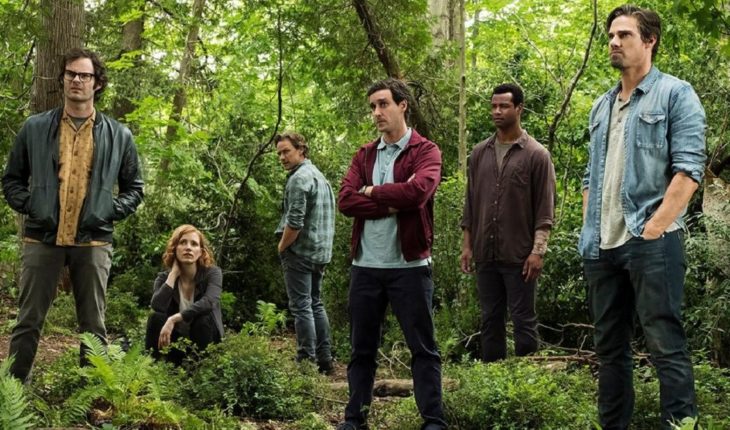Finally, “It (That) Chapter Two” (It Chapter Two, 2019) made it to theaters, and as is often the case with most adaptations, we could not pass up the opportunity to compare Stephen King’s original play with the sequel directed by Andy Muschietti, who, who directed Andy Muschietti, who, who directed Andy Muschietti, who, who directed Andy Muschietti, who, who, who directed Andy Muschietti, who, who directed and Andy Muschietti, who, who directed Andy Muschietti, who he decided to separate the narrative into two parts: the account of the little Losers and that of their adult versions, who must return to Derry 27 years later to face their fears… and this evil entity. Deaths, rituals, visions and motivations, all presented with subtle differences between the 1986 novel and the film that opens this week. Of course there are spoilers involved, so be careful if you don’t want us to ruin any surprises for you. ODIO CRIMES “It 2” begins in a terrifying way, but little has to do with the cursed clown with this start. While the scene in question was totally ignored in the 1990 television version and did not get into the first part directed by Muschietti, the director made sure to include her in this sequel out of respect for King himself. We talk about the brutal beating of Adrian Mellon (Xavier Dolan) at the hands of a homophobic group, while walking with his partner at the Derry fair. Don Hagarty (Taylor Frey) has a horror turn to witness how his half-orange is beaten to the edge of death and then thrown into the canal where he has his deadly encounter with Pennywise. The book scene is inspired by the murder of Charlie Howard, a real event that occurred in Bangor, Maine, in 1984. “It’s one of the things that made a profound impact on Stephen King when he was writing. So, he decided to include her. Of course, the names were changed, but the beating happened almost exactly as described in the book, and Charlie died in a metre of water in the canal,” Muschietti says of the importance of this moment, which he resolved to represent even more realistically including Howard’s asthmatic condition in his film.
Adrian, real-life character
THE SHOKOPIWAH DOES NOT KNOW ANYTHING The ritual of Ch’d is the product of Esteban’s little head and has great relevance within the pages of the novel, although little to do with Muschietti’s version. Literaryally speaking, the ritual is an esoteric practice that losers learn from a book about Himalayan mystical customs. The process involves tongues, bites and all sorts of weird things that for kids end up in a joke but, in reality, it’s a kind of metaphysical experience that binds two people together on another plane of existence. In “It Chapter Two,” adult Mike (Isaiah Mustafa) discovers this ritual at the hands of the Shokopiwah – a tribe of Native Americans – and, in this case, involves collecting objects of relevance in the past from his companions to be used as a sacrifice and, eventually banish that from their lives. Unfortunately, The ritual of Ch’d does not work in any of its forms.
Less effective than the banana ritual
LEAVING THE EQUATION No matter the version, the fate of Stanley Uris (Andy Bean) never changes. Stan doesn’t get to see his fellow Losers 27 years later because he decides to take his own life rather than go back to Derry and have to face Pennywise again. But Muschietti and screenwriter Gary Dauberman added one more dimension to this overly traumatized character. In “It 2”, Uris is a kind of martyr for the group, and even has the possibility to explain the reasons for his suicide in his own fist and letter. The letters that the survivors receive at the end of the film are not in the novel, nor the justification of Stan, who decided to “get off the board” because he was too scared to return and knew that what they had to do to defeat the entity, did not it would work if he hindered things. Stanley’s words and attitude only underscore the sense of unity and humanity of this story that goes beyond scares, blood and gore.
Before returning to Derry, dead
BASTA DE SECRETOS Unlike his peers, Richie Tozier does not have a particular encounter with his deepest fears in the first film. But Richie has a secret, which he fears will come to light. In the sequel, the comedian’s fears materialize when Paul Bunyon’s statue “comes to life,” but also in some bad memories of his youth. While in the novel, King reveals the good friendship that exists between the two characters, but becomes more ambiguous at the time of the attraction he secretly feels for his companion Eddie Kaspbrak (James Ransone), the filmmakers decided to give more relevance to this feature, beyond that Tozier never gets to reveal his true feelings. Eddie dies in the final showdown with That, but Richie has his personal catharsis moment when he records the initials of both on the wood, as any couple in love would.
Richie never with his mouth shut
MANY WAYS TO DIE Another who can’t escape the Grim Reaper, no matter the version, is the hypochondriac of Eddie Kapsbrak (James Ransone). In the novel, Pennywise rips off his arm after using his inhaler to poison him. He dies, basically, in Richie’s arms, in the middle of a confession that provokes his friend’s fit of rage. In the hands of the Muschietti brothers, Kapsbrak’s end is somewhat more heroic when he manages to take confidence and save Tozier’s life, slamming the clown/spider. Unfortunately, that takes revenge by stabking him in the chest with one of his claws. Eddie dies from blood loss and his body is abandoned in the sewers, the worst place for such a neurotic character.
Chronicle of a Death Announced
In this note:





